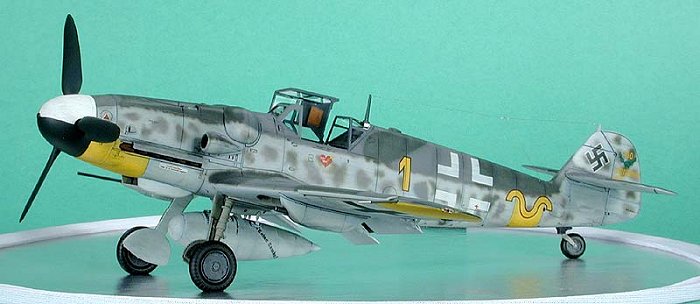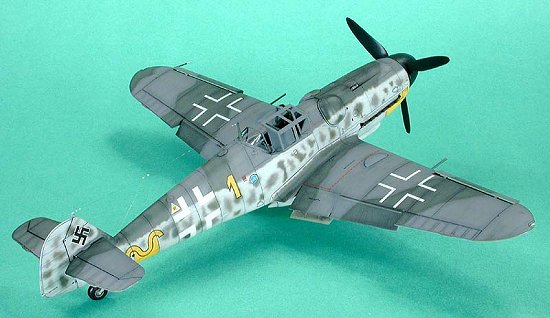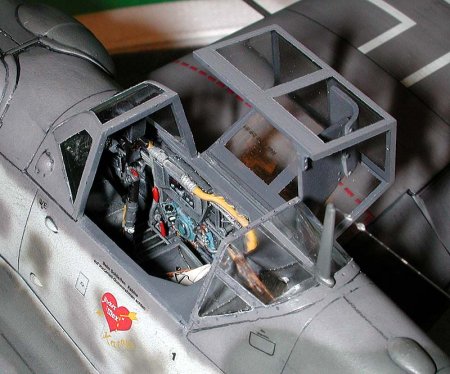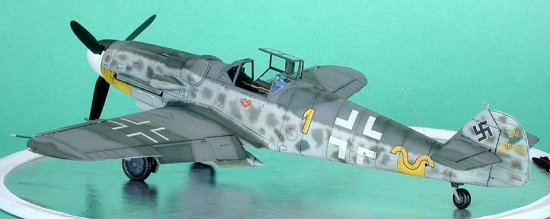
Tips &
Techniques – Water Color Washes and the Hasegawa 1/32 BF109G6
by
Bob Laskodi

I have decided I am bored doing the “traditional” kit review articles I have been contributing to Modeling Madness over the past few years, so I am going to take a different approach by highlighting a specific modeling technique in detail instead! This will (hopefully!) be the first of many modeling technique articles that you may find to be useful in your own builds.
I use a
slightly different wash technique than most modelers, using tube based
artist watercolors available at most art stores. I am always on the lookout
for different approaches to modeling and didn’t like the usual wash
techniques using turpentine, lighter fluid, paint thinner, or other
volatile substances. Besides the obvious toxicity and smell, these
substances  can affect the underlying paint surfaces requiring a clear coat,
and it can be difficult to erase mistakes. Using acrylic paints is a
slightly better alternative, but you still must use an ammonia-based
solution (window cleaner or other agents) to remove unwanted mistakes that
also can have an adverse effect on the underlying paint (I also hate the
ammonia smell).
can affect the underlying paint surfaces requiring a clear coat,
and it can be difficult to erase mistakes. Using acrylic paints is a
slightly better alternative, but you still must use an ammonia-based
solution (window cleaner or other agents) to remove unwanted mistakes that
also can have an adverse effect on the underlying paint (I also hate the
ammonia smell).
Watercolors are an obvious alternative to oil based washes. The pigments are actually finer than oil based paints, but water is a horrible thinning agent due to its high surface tension and adding wetting agents doesn’t help that much. The secret is to use an acrylic thinner with the watercolor. I use Pollys Airbrush Thinner, but most any acrylic thinner will work. Just place some watercolor pigment straight from the tube into a spare bottle and add thinner until you get the desired color density. There is no secret formula for thinner/pigment ratio as each brand of watercolor is different, and it doesn’t really matter any way since watercolors are so easy to remove and thin. Unlike oil-based washes that must be mixed prior to use, watercolor based washes have an indefinite shelf life and can be kept pre-mixed for months. If they get too thick, just add more acrylic thinner.
The biggest
advantage of watercolors is they are very simple to remove (just wash off
with water!). Apply the watercolor wash just like any other wash with a
fine tipped bulbous paintbrush and flow into the panel line/detail.
Watercolor washes do  not flow as well as oil based washes, but again you
don’t care since clean up is so simple. Just place a drop of water on a
cloth or cotton bud and remove as much wash as you want. Streaky effects
are easy to do, just lightly wipe in the direction of airflow leaving some
pigment behind. If you really screw up, just put it in the sink and turn on
the water. Problem solved with no damage to the underlying paint.
Non-toxic, not smelly, easy to remove, and easy to use get my vote any day!
not flow as well as oil based washes, but again you
don’t care since clean up is so simple. Just place a drop of water on a
cloth or cotton bud and remove as much wash as you want. Streaky effects
are easy to do, just lightly wipe in the direction of airflow leaving some
pigment behind. If you really screw up, just put it in the sink and turn on
the water. Problem solved with no damage to the underlying paint.
Non-toxic, not smelly, easy to remove, and easy to use get my vote any day!
I always apply my washes after the paint is fully cured, and all the decals are applied. I seal my decals with a gloss clear coat to prevent the wash from seeping underneath them, but you do not always need to apply a gloss coat since the water color wash will not damage underlying paint (unlike solvent based washes). However, you may want to apply a protective gloss coat on very light colored paints (such as white) to prevent the watercolors from “staining”. For the BF109 I applied a Payne’s Gray watercolor based wash to all the surface details, and then cleaned up the overruns as described above. After drying for a few hours I then sealed the model with a light coat of Testors Dullcote to prepare the surface for pastels and to “fill in the missed areas” with a sharp engineering pencil. Watercolor washes are more fragile than oil based washes and should be sealed as soon as possible with your favorite clear coat.
Here are the basic steps. You can enlarge these thumbnails by clicking on them.
Build Comments
 The kit is the
fantastic 1/32 Hasegawa BF109G6 (ST17) with Model Design Construction (MDC)
cockpit (CV32003) and wheels. All paints are Testors Model Master enamels.
The kit supplied decals are superb, and the scheme for Eric Hartmann was
used. There is absolutely nothing to report about the build, as it was as
“smooth as a baby’s behind” with no significant difficulties. The only
question I have is why I waited so long to build this thing!
The kit is the
fantastic 1/32 Hasegawa BF109G6 (ST17) with Model Design Construction (MDC)
cockpit (CV32003) and wheels. All paints are Testors Model Master enamels.
The kit supplied decals are superb, and the scheme for Eric Hartmann was
used. There is absolutely nothing to report about the build, as it was as
“smooth as a baby’s behind” with no significant difficulties. The only
question I have is why I waited so long to build this thing!
If you would like your product reviewed fairly and quickly by a site that has nearly 250,000 visitors a month, please contact me or see other details in the Note to Contributors.